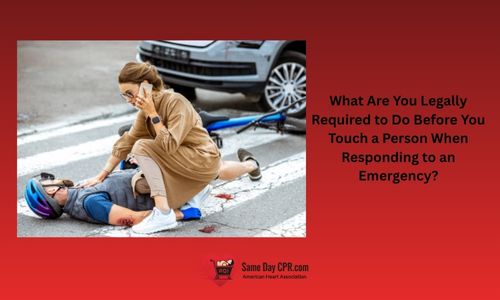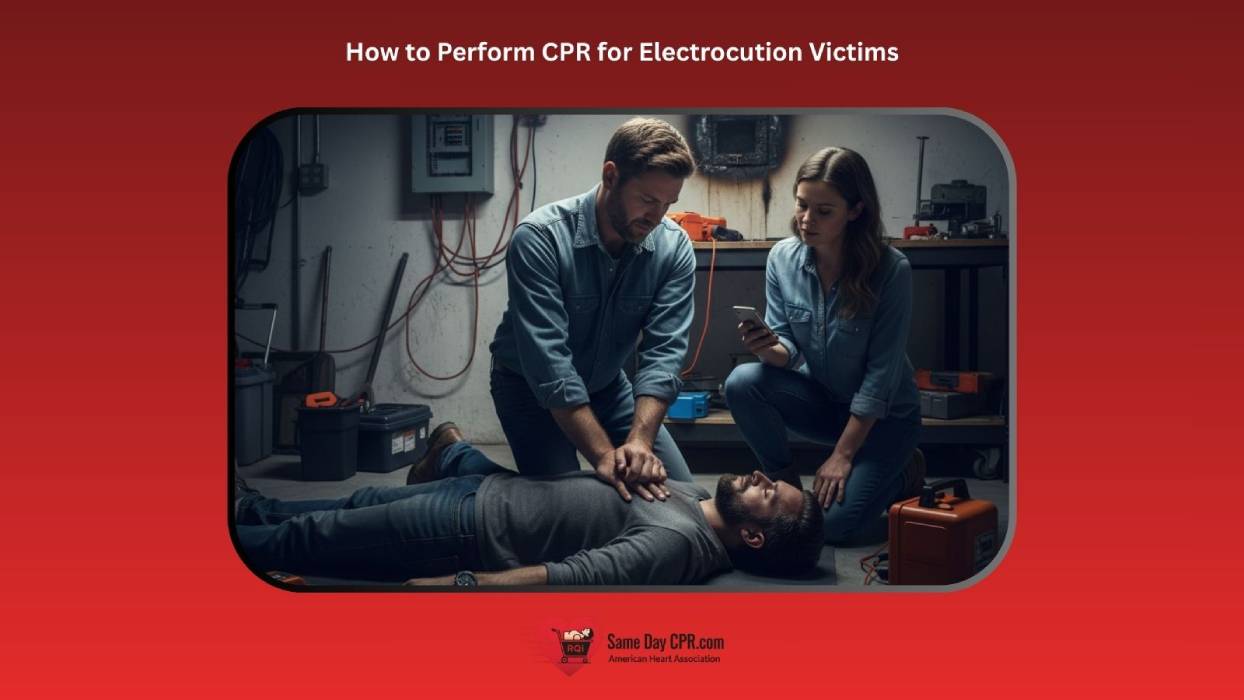When a medical emergency hits, knowing what you’re legally expected to do before you touch someone can protect both you and the person in need. Emergencies can happen anywhere and to anyone. They can involve accidents, cardiac arrest, heart attacks, drowning, choking, or severe injuries. Being ready and knowing how to respond can make a big difference in these situations. Especially when you understand what are the steps you should follow for any injury or environmental emergency to ensure a safe and effective response.
This guide clarifies the legal responsibilities of bystanders, first responders, and professionals, so you can act confidently and correctly. We’ll cover the basics everyone should know, from consent and duty to respond to the legal protections that can apply when you help in good faith. You’ll see how standards differ by location, why training matters, and how practical factors like CPR, first aid, AED use, and emergency transport play into the right course of action. This is about reducing risk, supporting ethical care, and guiding you to respond effectively when seconds count.
Key Legal Concepts and Protections
Understanding what a person must or must not do helps keep everyone safer and fairer in daily life.
1. Good Samaritan Protection Helps You Act Without Fear of Blame
If you step in to help during an emergency, the law often shields you from being sued for giving first aid in good faith. These protections usually cover your actions during the incident and sometimes until professionals arrive, though the rules vary by location.
2. You Must Stay Within Your Training and Do No Harm
Laws expect you to use common sense and only perform tasks you’re trained to do, avoiding procedures outside your skill level. Basic actions like checking responsiveness, calling for help, and giving chest compressions when trained are generally safe and encouraged.
3. Recording What You Did Can Be Important
If a legal issue arises, a simple record of what you did, the start time, and who you called can be helpful. In some areas, responders or authorities may ask for a brief report about your actions.
4. Your Actions Should Prioritize Safety for Everyone
Always assess danger before helping, and if the environment is risky, move to a safer location before providing aid. Protecting yourself reduces the chance of worsening the situation for everyone involved.
5. You Can Seek Guidance and Training to Be a Better Responder
Many regions offer first aid and CPR training that includes information about legal protections. Keeping certifications current gives you up-to-date skills, clarity on what you can safely do, and greater confidence to act quickly in emergencies.
6. If a person has DNR (Do Not Resuscitate) orders (if known)
If someone has a DNR order and you are aware of it, you should honor their wishes and not perform CPR or other resuscitation measures. Always check for legal documents or bracelets showing DNR status and follow instructions carefully to protect both the person and yourself.
What Are You Generally Allowed or Expected to Do Before Touching?
Before you step in to help, it’s important to know what you can and should do safely. These steps help you protect yourself while giving the right kind of care to the person in need.
1. Ensure Scene Safety
Before helping, quickly check that the area is safe for both you and the victim. Look for dangers like traffic, fire, electricity, or other hazards, and use PPE (personal protective equipment) suits, gloves or a mask if available.
2. Assess responsiveness and Obtain Consent
Approach calmly and identify yourself, then gently tap the person and ask if they are okay. If they can respond, always ask permission before providing care; if they are unresponsive, you can assume they would want help.
3. Check for Life-Threatening Conditions
Observe serious issues such as heavy bleeding, unconsciousness, abnormal breathing, or chest pain. Avoid unnecessary movement, especially if a spinal injury is suspected, while preparing to provide care.
4. Call for Help
If the situation seems urgent, call for help immediately and direct others nearby to assist. Provide the dispatcher with your exact location and a clear description of the emergency for faster response.
5. Prepare to Touch Only as Needed
Touch the person only when necessary, such as performing CPR, stopping bleeding, or moving them to safety. Explain each action in simple terms and use gentle, careful contact to avoid causing additional harm.
6. If Moving the Person Is Required for Safety
Move the person only if they are in immediate danger or care cannot be given otherwise. Keep movements gentle and limited, maintaining head and neck alignment if a spinal injury is possible, and use trained techniques like a logroll when needed.
7. Minimize Exposure and Protect Privacy
Protect the person’s dignity by covering them with a blanket or jacket whenever clothing must be moved for care. Small actions like this help them feel safer and more comfortable during treatment.
8. Monitor and Reassess
Stay with the person and continually observe breathing, airway, and responsiveness. Adjust your care as conditions change and be ready to call for additional help or start lifesaving steps calmly.
9. When in Doubt, Refer to Trained Professionals
If you’re unsure about what to do or if it may put you at risk, wait for trained responders. Stay nearby to reassure the person while keeping them safe until professionals arrive.
10. Aftercare and Handoff
When help arrives, relay all key details about what happened and the care you provided. Preserve the scene if investigation is needed and allow responders to take over smoothly.
Specific Scenarios and Practical Guidance
Different situations call for different actions, and knowing what to do can make a big difference. Here’s some practical guidance for helping others, depending on your training and where you are.
- Layperson Without Training: If you don’t have any medical training, focus on keeping yourself and the person safe. Call for help and follow the dispatcher’s instructions while staying calm and nearby.
- Trained Layperson (CPR/AED Certified): If you are trained in CPR or using an AED, you can step in confidently to provide care. Check the person, follow your training, and use the equipment as needed while waiting for help to arrive.
- Healthcare or EMS Professionals: As a healthcare or EMS (emergency medical services) professional, you can take charge and provide advanced care quickly. Use your skills to assess, treat, and stabilize the person while coordinating with your team and emergency services.
- In Public or Workplace Settings: In public or at work, stay calm and act quickly to help someone in need. Make sure the area is safe, call for help, and use any available resources like first aid kits or trained staff.
Special Considerations
Some situations need extra care or attention because of age, culture, or the type of injury. Here are a few special considerations to keep in mind when helping others.
- Pediatric and Elderly Patients: When helping children or older adults, be gentle and pay close attention to their needs. Their bodies can be more fragile, so move slowly and watch for any signs of distress.
- Religious or Cultural Considerations: Respect the person’s beliefs and traditions while giving care. Ask or observe what is acceptable and adjust your actions to honor their practices whenever possible.
- Penetrating Injuries, or Mass Casualty Events: For serious injuries or situations with many people hurt, focus on safety and call for professional help immediately. Provide basic care without causing more harm and follow any instructions from emergency responders.
Common Myths vs. Realities
There are a lot of misunderstandings about helping in an emergency, and they can make you hesitate. Let’s look at some common myths and the real facts behind them.
- Myth: You must always touch someone in an emergency.
Reality: Legal protections exist, but consent and safety considerations apply; avoid actions outside training or legal allowances.
- Myth: You can be sued for helping.
Reality: Good Samaritan laws provide protection when acting in good faith within trained scope; however, reckless or gross negligence can affect protections.
- Myth: You need to be a licensed professional to help.
Reality: Lay responders can provide aid within their training; professionals have additional protections and duties.
Consequences of Not Following Legal Procedures During Emergencies
Here are five key consequences of not following legal procedures during emergencies.
- Legal Liability: If you act outside your training or ignore consent rules, you could face lawsuits or criminal charges. Even well-intended actions can have consequences if they break the law, so knowing the rules helps you protect yourself.
- Harm to the Person: Failing to follow proper procedures can accidentally worsen injuries or put the person at more risk. Following guidelines ensures your care helps instead of causing harm.
- Loss of Trust: Ignoring legal and ethical rules can make bystanders, the person’s family, or even co-workers lose trust in you. Acting correctly builds confidence and reassurance in stressful situations.
- Professional Repercussions: For healthcare workers or trained responders, not following the law can lead to disciplinary actions, license suspension, or job consequences. It’s important to follow protocols to stay in good standing professionally.
- Emotional and Mental Stress: Making mistakes that break the law or harm someone can create guilt, anxiety, or stress afterward. Knowing the proper procedures helps you stay calm and confident while providing care.
Acting Responsibly and Legally in Emergencies
In summary, knowing what you’re legally required to do before touching someone in an emergency gives you a clear path to act safely and confidently. By checking the scene, getting consent when possible, staying within your training, and calling for help, you protect both yourself and the person in need. Following these steps, paying attention to special situations, and respecting legal protections like Good Samaritan laws can prevent harm, reduce stress, and make your actions more effective. Emergencies are stressful, but understanding your responsibilities helps you stay calm, provide the right care, and make a real difference when it matters most.








